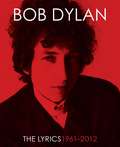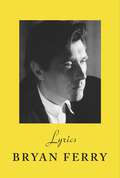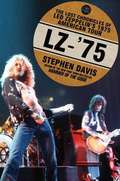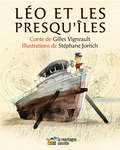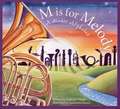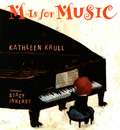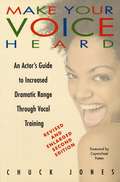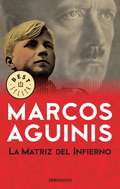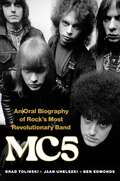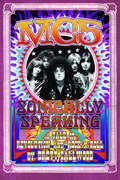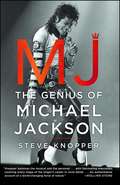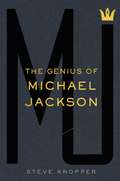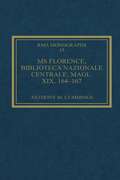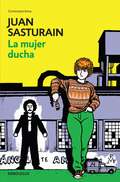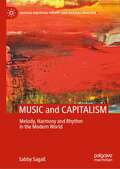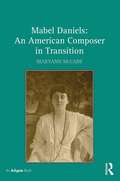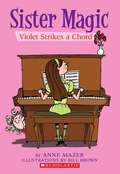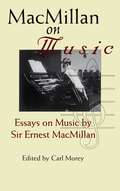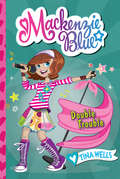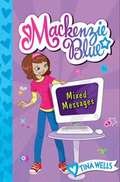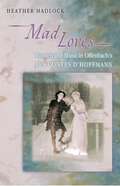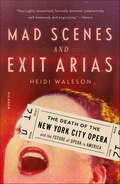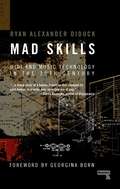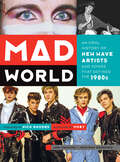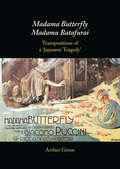- Table View
- List View
Lyrics: 1962-2001
by Bob DylanA major publishing event—a beautiful, comprehensive collection of the lyrics of Bob Dylan with artwork from thirty-three albums, edited and with an introduction by Christopher Ricks.<P><P> As it was well put by Al Kooper (the man behind the organ on “Like a Rolling Stone”), “Bob is the equivalent of William Shakespeare. What Shakespeare did in his time, Bob does in his time.” Christopher Ricks, editor of T.S. Eliot, Samuel Beckett, Tennyson, and The Oxford Book of English Verse, has no argument with Mr. Kooper’s assessment, and Dylan is attended to accordingly in this authoritative edition of his lyrics.<P> In the words of Ricks: “For fifty years, all the world has delighted in Bob Dylan’s books of words and more than words: provocative, mysterious, touching, baffling, not-to-be-pinned-down, intriguing, and a reminder that genius is free to do as it chooses. And, again and again, these are not the words that he sings on the initially released albums.”<P> This edition changes things, giving us the words from officially released studio and live recordings, as well as selected variant lyrics and revisions to these, recent revisions and retrospective ones; and, from the archives, words that, till now, have not been published.<P> The Lyrics, edited with diligence by Christopher Ricks, Lisa Nemrow, and Julie Nemrow. As set down, as sung, and as sung again.<P> Winner of the Nobel Prize for Literature
Lyrics: The definitive collection of the Roxy Music frontman’s iconic lyrics
by Bryan Ferry**THE SUNDAY TIMES BESTSELLER**Celebrate the 50th anniversary of Roxy Music's iconic first album with this collection of Bryan Ferry's evocative lyrics of aspiration and romantic longing, introduced by the author.'Lyrics is a book any Roxy fan would be proud to have on their shelf' The TelegraphBryan Ferry's work as a singer and songwriter, both as a solo artist and with Roxy Music, is legendary.Lyrics collects the words written for music across seventeen albums, from the first iconic Roxy album of 1972 via the masterpiece of Avalon to 2014's reflective Avonmore, introduced by the author, and with an insightful essay by James Truman.All the classic Roxy anthems are here - 'Virginia Plain', 'Do the Strand', 'Love is the Drug' - songs in which the real and the make-believe blend in a kaleidoscopic mix, shot through with cinematic allure.Also included are the evocative lyrics of romantic longing and lost illusions for which Ferry is rightly revered: 'Slave to Love', 'Mother of Pearl', 'More Than This'. As he writes in his preface, 'The low points in life so often produce the most keenly felt and best-loved songs.' And, it might be added, some of the best poetry.Discover this unforgettable collection of Bryan Ferry's work today.
Lz-'75
by Stephen DavisStephen Davis's brilliantly-written personal account of criss-crossing America with Led Zeppelin on their 1975 tour. A warts-and-all snapshot of the world's biggest hard-rock band at their peak. As a young rock writer Stephen Davis landed the ultimate commission - touring America with Led Zeppelin. This is a personal account by Davis of his journey, which saw him crossing the country with the band on board the Starship, their famous Boeing passenger jet, complete with deep shag purple carpet, electric pianos, girlfriends and star-struck hangers-on. This is also the story of one of the hardest-living bands in the world at their peak. For Robert Plant, Jimmy Page, John Paul Jones and John Bonham, the most beautiful women in America tear their spangled jackets from them and riots start outside their gigs. LZ-75 captures a few perfect months in rock, when Led Zeppelin epitomised the free-living rock dream, but, like Icarus, their wings were already beginning to melt. It wouldn't be long before John Bonham died of a vodka overdose, and punk killed their brand of monumental rock. With it's up-close-and-personal accounts of band members, managers, groupies, fans and drug-dealers, there's a lot of Almost Famous about this book - Led Zep's 1975 tour is in fact the very one on which Cameron Crowe's film was based. Stephen Davis was barely twenty in 1975, but now he is recognised as one of the best rock writers in the world. He is the author of the mega-selling Hammer of the Gods - a biography of Led Zeppelin. He recently unearthed his notebooks of the 1975 tour - which he didn't use for Hammer of the Gods - to write LZ-75. LZ-75: ACROSS AMERICA WITH LED ZEPPELIN is a wonderful and unique thing - a beautifully succinct account of a single moment in rock, when no lyric was too far-fetched, no drink went undrunk and no expense was ever, ever spared. It's a moment that will never be repeated.
Léo et les presqu'îles
by Gilles VigneaultCette magnifique fable relate l'aventure de LÉo, le fils d'un pÊcheur disparu en mer. Parti explorer le monde des cinq presqu'Îles, LÉo fait la rencontre de personnages hauts en couleur qui ont bien connu son pÈre. Avec leur aide, il devient le plus petit capitaine d'un grand bateau. Un livre sur la transmission familiale, et la soif de dÉcouverte !
M Is for Melody: A Music Alphabet
by Kathy-Jo WarginA music lesson in alphabet form that includes instruments, terms, composers, and music styles.
M is for Music
by Kathleen KrullMusic and the alphabet have always gone together. Don't kids learn their letters by singing the ABCs? But you've never seen--orheard--a musical alphabet like this one. Beloved tunes. Unusual instruments. Legendary virtuosos. From anthems to zydeco, the language of music and the music of language harmonize in one superb symphony. It's a funky fusion for songsters of all ages! Playful text opens up the world of music to the youngest readers, and conversational endnotes offer older readers a springboard to further musical explorations.
MAKE YOUR VOICE HEARD: An Actor's Guide to Increased Dramatic Range through Vocal Training
by Chuck JonesJones, a vocal coach and teacher, provides exercises and tips for vocal power and projection for actors, based on a methods created by British teacher Iris Warren. He details exercises for the body, vocal passageway, breathing, and resonating chambers. Chapters discuss John Barrymore and his teacher as examples. Vocal honesty, projection, character and gender, emotion, and professionalism are also detailed. The new edition has chapter by coaches who trained with Jones, and they describe alignment and pregnancy and vocal workouts. Annotation ©2006 Book News, Inc. , Portland, OR (booknews. com)
MATRIZ DEL INFIERNO, LA (EBOOK)
by Marcos AguinisVertiginosa y estremecedora, la novela de Marcos Aguinis es también la biografía de una época. La acción ocurre en la Argentina y luego en Alemania. Sus protagonistas Rolf, Edith, Alberto, conforman un triángulo que ciñe los conflictos políticos y sociales de la década del treinta (llamada con justicia "infame"). La mujer que atrae, por motivos bien distintos, a esos dos hombres, pronto sabrá que está en el umbral del fuego, en los albores de la destrucción y el Holocausto. Desfilan en el fondo los artífices de la tragedia: el general Félix Uriburu, el periodista Ernesto Alemann, el cardenal Eugenio Pacelli, Himmler, Goebbels y el propio Hitler. El autor toma como punto de partida hechos y personajes reales y logra vertebrar con ellos una narración plena de intriga que transcribe la tensión de los años de mayor incertidumbre y beligerancia ideológica del siglo. Todos los personajes de La matriz del infierno se acercan y se rechazan, obedientes a sus pasiones y, a la vez, a la fatalidad histórica. Gracias al talento y a la penetración del autor de La cruz invertida y Elogio de la culpa, los lectores somos conducidos al núcleo de una realidad compleja cuyas consecuencias aún hoy -hoy más que nunca- nos conciernen.
MC5: An Oral Biography of Rock's Most Revolutionary Band
by Brad Tolinski Jaan Uhelszki Ben EdmondsA riveting oral biography of the proto-punk Detroit rockers MC5, based on original interviews with the band and key members of their inner circle Few bands have dared to ignite a revolution through their fusion of activism and art like MC5. Managed by the charismatic radical and hippie spokesman, John Sinclair, MC5 wasn&’t just a band; they were a thunderous proclamation of dissent, amplifying the voices of the marginalized long before it was fashionable. From championing racial equality to rallying for cannabis legalization, they fearlessly thrust their beliefs onto the world stage. For their efforts, the rabble-rousing musical arm of the White Panther Party, the scourge of J. Edgar Hoover's FBI and other defenders of public decency, were often beaten with clubs, threatened at gunpoint, tossed into jail, and even unceremoniously dumped by their record company, right as their album was storming up the charts—and all while the Sex Pistols were still on training wheels. What has been lost amidst this notoriety is MC5 itself, a band worth remembering not because they were bad boys, but because they were so damn good. In MC5: An Oral Biography of Rock&’s Most Revolutionary Band, music journalists Brad Tolinski and Jaan Uhelszki invite readers to reconsider this legendary group. Centered around a series of interviews with MC5, their manager, and their inner circle—many of whom are no longer with us—that Tolinski and Uhelszki inherited from CREEM Magazine founding staffer and Mojo's US editor Ben Edmonds prior to his death, this book presents a genuinely candid, funny, and moving portrait of rock&’s most uncompromising and articulate band. MC5 also features a virtual &“who&’s who&” of 1960s rockers, including Iggy and the Stooges, Janis Joplin, Jimi Hendrix, promoter Bill Graham, John Lennon, the Jefferson Airplane, and political firebrands like Abbie Hoffman, Jerry Rubin, Tom Hayden, and Black Panther Eldridge Cleaver. As innovative, insightful, and inspiring as the band itself, MC5 is a fitting testament to the legacy of these iconic rock pioneers—told in their very own words.
MC5: Sonically Speaking
by Brett CallwoodA definitive history of the MC5 that considers the band's musical legacy and revolutionary political roots.
MJ: The Genius Of Michael Jackson
by Steve KnopperThe ultimate critical biography of the King of Pop: a panoramic, vivid, and incisive portrait of Michael Jackson that explores and celebrates his influence in music, dance, and popular culture, drawing on 400 interviews.From the moment in 1965 when he first stepped on stage with his brothers at a local talent show in Gary, Indiana, Michael Jackson was destined to become the undisputed King of Pop. In a career spanning four decades, Jackson became a global icon, selling over 400 million albums, earning thirteen Grammy awards, and spinning dance moves that captivated the world. Songs like "Billie Jean" and "Black and White" altered our national discussion of race and equality, and Jackson's signature aesthetic, from the single white glove to the moonwalk, defined a generation. Despite years of scandal and controversy, Jackson's ultimate legacy will always be his music. Rolling Stone contributing editor Steve Knopper delves deeply into Michael Jackson's music and talent. From the artist's early days with the Jackson 5, to his stratospheric success as a solo artist, to "Beat It" and "Thriller," "Bad" and "The Man in the Mirror," to his volatile final years, his attempted comeback, and untimely death, Knopper explores the beguiling and often contradictory forces that fueled Michael Jackson's genius. Drawing on an amazing 400 interviews--ranging from Jackson's relatives, friends, and key record executives to celebrities like will.i.am and Weird Al Yankovic--this critical biography puts all the elements of his career into perspective, and celebrates his triumph in art and music. This is a rare and panoramic view into the genius and influence of an incomparable talent.
MJ: The Genius of Michael Jackson
by Steve KnopperThe ultimate critical biography of the King of Pop: a panoramic, vivid, and incisive portrait of Michael Jackson that explores and celebrates his influence in music, dance, and popular culture, drawing on 400 interviews. From the moment in 1965 when he first stepped on stage with his brothers at a local talent show in Gary, Indiana, Michael Jackson was destined to become the undisputed King of Pop. In a career spanning four decades, Jackson became a global icon, selling over 400 million albums, earning thirteen Grammy awards, and spinning dance moves that captivated the world. Songs like "Billie Jean" and "Black and White" altered our national discussion of race and equality, and Jackson's signature aesthetic, from the single white glove to the moonwalk, defined a generation. Despite years of scandal and controversy, Jackson's ultimate legacy will always be his music. Rolling Stone contributing editor Steve Knopper delves deeply into Michael Jackson's music and talent. From the artist's early days with the Jackson 5, to his stratospheric success as a solo artist, to "Beat It" and "Thriller," "Bad" and "The Man in the Mirror," to his volatile final years, his attempted comeback, and untimely death, Knopper explores the beguiling and often contradictory forces that fueled Michael Jackson's genius. Drawing on an amazing 400 interviews--ranging from Jackson's relatives, friends, and key record executives to celebrities like will.i.am and Weird Al Yankovic--this critical biography puts all the elements of his career into perspective, and celebrates his triumph in art and music. This is a rare and panoramic view into the genius and influence of an incomparable talent.
MS Florence, Biblioteca Nazionale Centrale, Magl. XIX, 164-167 (Royal Musical Association Monographs)
by AnthonyM. CummingsManuscript Florence, Biblioteca Nazionale Centrale, Magliabechiana XIX, 164-167 (FlorBN Magl. 164-7) has been the subject of considerable scholarly attention. The prevailing assumption had been that it was a Florentine source of the early sixteenth century. More recently, it has been argued that its provenance is not as easily determined as it first appears, and that there are Roman connections suggested by one of its codicological features. This monograph provides as full a bibliographical and codicological report on FlorBN Magl. 164-7 as is currently possible. Such evidence suggests that the earlier thesis is more likely to be correct: the manuscript was copied in Florence c.1520. After a review of the evidence for provenance and date, the repertory of the manuscript is placed in its historical and cultural context. Florence of the early sixteenth century is shown to have an organized cultural life that was characterized by the activities of such institutions as the Sacred Academy of the Medici, the famous group that met in the garden of the Rucellai, and others. FlorBN Magl. 164-7 is an exceedingly interesting and important source; an eclectic repository not only of compositionally advanced settings of Petrarchan verse by Rucellai-group intimate Bernardo Pisano but also of sharply contrasting works, popular in character. It is almost a manifesto of the sensibilities of preeminent Florentine cultural figures of the sort who frequented the garden of the Rucellai and as such is a revealing document of Florentine musical taste during those crucial years that witnessed the emergence of the new secular genre we know as the Italian madrigal.
MUJER DUCHA, LA (EBOOK)
by Juan SasturainUn libro de relatos de Juan Sasturain es una galería de mundos y paisajes bien definidos y diferenciados, siempre memorables. En obras de esta índole, el lector, atento al rastro de cada personaje, convierte la evasión en encantamiento, el gusto en adicción. Es difícil salir ileso de estas historias que nos permiten revivir emociones sumergidas en la nostalgia: los mitos del fútbol tal como eran en la infancia, imaginar de nuevo el pasado remoto, los caballeros andantes y sus proezas épicas. Todo eso y más ocurre en La mujer ducha, aunque el elogio del libro no pueda siquiera rozar la experiencia de leerlo.
MUSIC and CAPITALISM: Melody, Harmony and Rhythm in the Modern World (Critical Political Theory and Radical Practice)
by Sabby SagallThis book argues that the need for music, and the ability to produce and enjoy it, is an essential element in human nature. Every society in history has produced some characteristic style of music. Music, like the other arts, tells us truths about the world through its impact on our emotional life. There is a structural correspondence between society and music. The emergence of 'modern art music' and its stylistic changes since the rise of capitalist social relations reflect the development of capitalist society since the decline of European feudalism. The leading composers of the different eras expressed in music the aspirations of the dominant or aspiring social classes. Changes in musical style not only reflect but in turn help to shape changes in society. This book analyses the stylistic changes in music from the emergence of ‘tonality’ in the late seventeenth century until the Second World War.
Mabel Daniels: An American Composer In Transition
by Maryann McCabeMabel Daniels (1877–1971): An American Composer in Transition assesses Daniels within the context of American music of the first half of the twentieth century. Daniels wrote fresh sounding works that were performed by renowned orchestras and ensembles during her lifetime but her works have only recently begun to be performed again. The book explains why works by Daniels and other women composers fell out of favor and argues for their performance today. This study of Daniels’s life and works evinces transition in women’s roles in composition, the professionalization of women composers, and the role that Daniels played in the institutionalization of American art music. Daniels’s dual role as a patron-composer is unique and expressive of her transitional status.
Mabel Strikes a Chord (Sister Magic #4)
by Anne MazerThe family has gotten a piano that Mabel loves to play. When five-year-old Violet learns Mabel is going to play in a concert, she wants to join in.
MacMillan on Music: Essays by Sir Ernest MacMillan
by Ernest Macmillan Carl MoreyIn addition to his activities as conductor, administrator, educator, composer, and organist, Sir Ernest MacMillan (1893-1973) found time to write more than one hundred essays and lectures on music. Always ready to use his enormous prestige to further the causes of music, MacMillan took every opportunity to admonish Canadians to develop our own composers, to honour our own performers, to educate our children musically, and to offer opportunities for all to hear, learn about, and enjoy great music.This selection of twenty essays and lectures covers the period from 1928 to 1964, and ranges over the gamut of MacMillan’s life and interests: the cause of the Canadian composer; music education for adults as well as children; critical reviews; his early years as an organist; internment in a German prison camp during the First World War; Shakespeare and music; church music; and the lighter side in two humorous send-ups of academic lectures on Bach and Wagner. Here is a panorama of music over thirty-five years at mid-century, through the eyes of one of Canada’s most brilliant and all-embracing musicians.
Mackenzie Blue #5: Double Trouble
by Tina Wells Michael SegawaMackenzie Blue is a star! Or she will be . . . as soon as she gets the part of an aspiring singer on a new TV pilot! But juggling auditions and the rest of her life turns out to be harder than Zee thought. Zee's friends are helping her hold everything together. But Zee doesn't like having to bail on plans--and her friends--to run to another audition. Is being a star worth it?Fans of the Dork Diaries will snap up the fifth book in this tween illustrated series about a twelve-year-old girl trying to survive middle school.
Mackenzie Blue: Mixed Messages
by Tina WellsMackenzie Blue and her crew are plugged in! Zee and her band, The Beans, are getting ready for their biggest show yet! Everyone's talking about it online at Bluetopia-the coolest social-networking site ever. Top three reasons that Bluetopia is the best: I can keep all my thoughts safe in a private blog, and I won't have to worry about anyone stealing my diary (finally)! The Beans have a huge show coming up, and we can make sure everyone knows about it! Jasper (my best guy friend) is in the spotlight for creating the site. He's so talented-he deserves it.
Mad Loves: Women and Music in Offenbach's Les Contes d'Hoffmann (Princeton Studies in Opera #16)
by Heather HadlockIn a lively exploration of Jacques Offenbach's final masterpiece, Heather Hadlock shows how Les Contes d'Hoffmann summed up not only the composer's career but also a century of Romantic culture. A strange fusion of irony and profundity, frivolity and nightmare, the opera unfolds as a series of dreamlike episodes, peopled by such archetypes as the Poet, the Beautiful Dying Girl, the Automaton, the Courtesan, and the Mesmerist. Hadlock shows how these episodes comprise a collective unconscious. Her analyses touch on topics ranging from the self-reflexive style of the protagonist and the music, to parallels between nineteenth-century discourses of theater and medical science, to fascination with the hysterical female subject. Les Contes d'Hoffmann is also examined as both a continuation and a retraction of tendencies in Offenbach's earlier operettas and opéra-comiques. Hadlock investigates the political climate of the 1870s that influenced the composer's vision and the reception of his last work. Drawing upon insights from feminist, literary, and cultural theory, she considers how the opera's music and libretto took shape within a complex literary and theatrical tradition. Finally, Hadlock ponders the enigmas posed by the score of this unfinished opera, which has been completed many times and by many different hands since its composer's death shortly before the premiere in 1881. In this book, the "mad loves" that drive Les Contes d'Hoffmann--a poet's love, a daughter's love, erotic love, and fatal attraction to music--become figures for the fascination exercised by opera itself.
Mad Scenes and Exit Arias: The Death of the New York City Opera and the Future of Opera in America
by Heidi WalesonFrom the Wall Street Journal’s opera critic, a history of how and why the New York City Opera went bankrupt—and what it means for the future of the arts.In October 2013, the arts world was rocked by the news that the New York City Opera—“the people’s opera”—had finally succumbed to financial hardship after 70 years in operation. The company had been a fixture on the national opera scene—as the populist antithesis of the grand Metropolitan Opera, a nurturing home for young American talent, and a place where new, lively ideas shook up a venerable art form. But NYCO’s demise represented more than the loss of a cherished organization: it was a harbinger of massive upheaval in the performing arts—and a warning about how cultural institutions would need to change in order to survive.Drawing on extensive research and reporting, Heidi Waleson, one of the foremost American opera critics, recounts the history of this scrappy company and reveals how, from the beginning, it precariously balanced an ambitious artistic program on fragile financial supports. Waleson also looks forward and considers some better-managed, more visionary opera companies that have taken City Opera’s lessons to heart.Above all, Mad Scenes and Exit Arias is a story of money, ego, changes in institutional identity, competing forces of populism and elitism, and the ongoing debate about the role of the arts in society. It serves as a detailed case study not only for an American arts organization, but also for the sustainability and management of nonprofit organizations across the country.“An intricate whodunit that seeks to find out who murdered the New York City Opera. . . . Waleson gives us a vivid description of each death-defying crisis and a sharp portrait of the ever-changing cast of would-be saviors who somehow always failed in their mission.” —The New York Times Book Review“Thoroughly researched, factually detailed, judgmentally well-balanced, and engrossing.” —Opera“Waleson’s in-depth study illustrates the challenges City Opera—and other opera houses—face in the 21st century as they seek to preserve tradition and innovate.” —Publishers Weekly“A thorough recounting of the tumultuous history of the New York City Opera [and] a cleareyed examination of the economic fragility of cultural institutions.” —Kirkus Reviews
Mad Skills: MIDI and Music Technology in the Twentieth Century
by Ryan DiduckA cultural history of MIDI (the Musical Instrument Digital Interface), one of the most revolutionary and transformative technologies in the history of music.A history of electronic music that goes way beyond the Moog. Part rigorous history, part insightful commentary, and part memoir, Mad Skills tells the story behind MIDI, aka the Musical Instrument Digital Interface, through the twentieth century's kaleidoscopic lens. Guiding us across one hundred years of musical instruments, and the music made with them, Mad Skills recounts the technical and creative innovations that led to the making of the most vital, long-standing, ubiquitous, and yet invisible music technology of our time.
Mad World: An Oral History of New Wave Artists and Songs That Defined the 1980s
by Jonathan Bernstein Lori MajewskiA &“hugely entertaining&” history of the 1980s New Wave music scene told through new interviews with its biggest artists (Rolling Stone). Mad World is a compelling oral history that celebrates the New Wave music phenomenon of the 1980s via new interviews with 35 of the most notable artists of the period. Each chapter begins with a discussion of their most popular song and leads to stories of their history and place in the scene, ultimately painting a vivid picture of this colorful, idiosyncratic time. Mixtape suggestions, fashion sidebars, and quotes from famous contemporary admirers help fill out the fun. Participants include members of Duran Duran, New Order, The Smiths, Tears for Fears, Adam Ant, Echo, and the Bunnymen, Devo, ABC, Spandau Ballet, A Flock of Seagulls, Thompson Twins, INXS, and more. &“One addictive chapter after another.&” —Rob Sheffield, author of Talking to Girls About Duran Duran &“Tells the tale of some of the decade&’s most unforgettable songs . . . in fascinating detail, letting the architects of these memorable records shine a light on how the sound of a generation came to be.&” —The Hollywood Reporter &“The new wave era is often dismissed for its one-hit wonders and silly haircuts, but [Mad World] examines the period with a great deal of love and reverence.&” —Buzzfeed &“A really informative and insightful read.&” —People
Madama Butterfly/Madamu Batafurai: Transpositions of a 'Japanese Tragedy'
by Arthur GroosPuccini's famous but controversial Madama Butterfly reflects a practice of 'temporary marriage' between Western men and Japanese women in nineteenth-century treaty ports. Groos' book identifies the plot's origin in an eye-witness account and traces its transmission via John Luther Long's short story and David Belasco's play. Archival sources, many unpublished, reveal how Puccini and his librettists imbued the opera with differing constructions of the action and its heroine. Groos's analysis suggests how they constructed a 'contemporary' music-drama with multiple possibilities for interpreting the misalliance between a callous American naval officer and an impoverished fifteen-year-old geisha, providing a more complex understanding of the heroine's presumed 'marriage'. As an orientalizing tragedy with a racially inflected representation of Cio-Cio-San, the opera became a lightning rod for identity politics in Japan, while also stimulating decolonizing transpositions into indigenous theatre traditions such as Bunraku puppet theatre and Takarazuka musicals.
